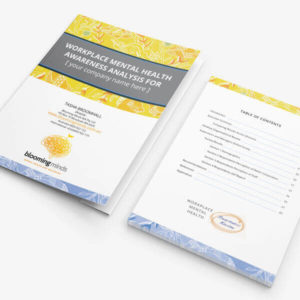Nowadays we hear a lot about mental health and wellbeing in the workplace, however we are usually only hearing about it in relation to the costs associated with mental health issues.
Mental health is a part of our general health and during our lifetime approximately half of us will experience mental health issues.
Mental Health Issues in the Workplace
What many organisations fail to capitalise on is that rather than waiting for mental health issues to have negative impacts in their workplace, they can benefit from deliberate action to proactively look after their employees’ mental health and wellbeing.
However, many organisations choose to wait
They don’t have an organisational fitness plan for their employees’ mental health and they don’t use a preventative approach. Instead, they wait until things are broken and then scramble to fix them.
Using ongoing preventative strategies to look after their employees’ mental health and wellbeing would provide the opportunity for employees to be and stay mentally healthy.
Mental wellbeing needs to be an active process
This is not to say that an employee’s mental wellbeing is the responsibility of the employer. There is very strong evidence that happy and healthy employees are good for business profitability. In addition, unwell employees can serve to drain resources and reduce profitability and productivity. It makes good business sense to not ignore this issue.
Instead, organisations need to be able to appropriately recognise and respond to mental health issues in employees. In addition, they need to minimise workplace risk factors for mental health issues, and provide opportunities for employees to positively enhance their mental health and wellbeing. Add to this that most organisations care about their employees, it’s not simply an economic issue, it’s a human issue.
Leaders, managers and supervisors
Despite the high prevalence of mental health issues in the workplace many managers and supervisors do not know how to appropriately respond to mental health issues in their employees.
Consider the leaders in your organisation. Do they:
- Know how to recognise and appropriately discuss mental health concerns with an employee?
- Understand their obligations around privacy and confidentiality?
- Know how to design and implement reasonable adjustments for staff with mental health issues that support both the individuals’ and the business’s needs?
Consider this Workplace Mental Health for Leaders course.
Australian businesses lose $10.9 billion each year to mental health issues in the workplace
Work related mental stress Workers’ Compensation claims have doubled in recent years. They are the most expensive form of Workers’ Compensation claim because they usually involve lengthy periods of absence(4).
Poor psychological and physical health is having a serious impact on worker wellbeing and productivity. This results in increased costs to employers. Research indicates that job stressors such as an ‘unhealthy’ workplace, work overload, or a traumatic work incident can contribute to the development of mental illness(4), or exacerbate already existing illnesses. Find out about our Psychosocial Safety MasterClass Series.
The law
As well as the costs, the law requires that organisations provide reasonable adjustments for employees with mental health issues and that employers do not discriminate against an employee on the grounds of mental health issues or disability.
Impact on individuals in the workplace
The workplace impacts of mental health issues can vary greatly from one individual to another. Whether an individual needs to disclose their illness or not may also differ depending on the type, frequency and impact of their symptoms. Sometimes it will be very clear that a person is experiencing mental health issues, but at other times it might not.
Individuals may experience variations in the severity of the functional impacts caused by their mental health issues , and they may need different levels and types of support. Organisations have traditionally not been good at responding with an individual approach to an issue that is often shrouded in misunderstanding, stereotype and stigma.
Health and safety
For many years, organisations have significantly invested in supporting the health and safety of their employees. They have been provided with training to understand safety issues in the workplace and to recognise risks to their physical health.
Organisations have developed specific elective programs for employees to increase their physical health and minimise risks to the organisation. This approach has targeted areas such as manual handling training, hazard awareness, blood pressure testing, weight management plans and physical exercise programs.
However, these programs have not widely been extended to include mental health and wellbeing.
Does not make good business sense
Despite one in five adults experiencing mental health problems each year(1), nearly half of all senior managers believe none of their workers will experience a mental health problem in the workplace(4). Given the numbers, sticking their heads in the sand does not make good business sense.
Mental health issues are real and relevant in the workplace. It is far better to develop a strategy to minimise the impacts and costs – both human and economic.
Think for a moment of mental health lying on a continuum
On one end, there are periods of being very unwell and struggling, and on the other end there are periods of being really well and buoyant. At any given time, our mental health might fluctuate up and down on this continuum.
Sometimes we may feel like we are on the unwell side of things and we may not feel that we have the capacity to cope with the problems we are facing. We might start to feel a little detached from those around us and withdraw or find ourselves in unhealthy relationships.
On the flip side, there may be times when we feel like we are floating along calmly – we may feel that we can find solutions to the challenges that we are facing, and we are engaged in healthy, positive relationships. We may frequently float back and forth on this continuum depending on what is happening in our life.
Important
It’s important to note, however, that even when you are on the unwell side of the continuum, you can be well supported and have good resources and still be able to function in the roles and relationships that are important to you. You can still be enjoying life and living it to the best of your circumstances. But you may not always feel like it, which is even more reason to positively strive to support your mental health and wellbeing.
References
- Australian Bureau of Statistics 2007, National Survey of Mental Health and Wellbeing: Summary of Results 2007 date viewed 30/8/2015
- Price Waterhouse Coopers, 2014, Creating a mentally healthy workplace return on investment analysis, Price Waterhouse Coopers, viewed 30/8/2015 < https://www.headsup.org.au/docs/default-source/resources/beyondblue_workplaceroi_finalreport_ may-2014.pdf>
- Medibank Private, 2008, The Cost of Workplace Stress in Australia, Medibank Private, viewed 30/8/2015 https://www.medibank.com.au/livebetter/newsroom/post/workplace-stress-costing-the-australian-economy
- Australian Human Rights Commission 2010, 2010 Workers with Mental Illness: a Practical Guide for Managers, Australian Human Rights Commission, date viewed 30/8/2015
- Broomhall T, 2014, Mental Health in the Workplace Survey, Blooming Minds
- Sane Australia, n.d., Fact Sheets- Anxiety Disorders, date viewed 30/8/2015 https://www.sane.org/information-and-resources/facts-and-guides/anxiety-disorder
- Kitchener, B.A, Jorm A.F, Kell C.M., 2013, Mental Health First Aid Manual. 3rd ed. Melbourne: Mental Health First Aid Australia
Tap into our mental health expertise
Image: Rodeo Project (Unsplash)



